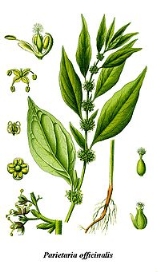
Parietaria officinalis
Encyclopedia
Parietaria officinalis, the Pellitory-of-the-wall, also known as lichwort, is a plant of the nettle
family. Its leaves, however, are non-stinging. The plant grows on rubbish and on walls, hence the name. It was once used as a medicinal herb and in the making of certain metheglin
s.
It is in a different family from Anacyclus pyrethrum
, also called pellitory.
Besides its diuretic
, emollient and depurative properties, it is necessary to mention its pectoral properties , very useful for the cure of bronchial affections and asthma
. In this case , half a spoonful of the powder of the dry leaves should be taken three times to the day .
Urticaceae
Urticaceae, or the nettle family, is a family of flowering plants. The family name comes from the genus Urtica . Urticaceae includes a number of well-known and useful plants, including the aforementioned nettles, Ramie , māmaki , and ajlai .The family includes approximately 2600 species, grouped...
family. Its leaves, however, are non-stinging. The plant grows on rubbish and on walls, hence the name. It was once used as a medicinal herb and in the making of certain metheglin
Mead
Mead , also called honey wine, is an alcoholic beverage that is produced by fermenting a solution of honey and water. It may also be produced by fermenting a solution of water and honey with grain mash, which is strained immediately after fermentation...
s.
It is in a different family from Anacyclus pyrethrum
Anacyclus pyrethrum
Anacyclus pyrethrum is a perennial herb much like chamomile in habitat and appearance...
, also called pellitory.
Internal use
This plant constitutes a very effective diuretic, and is ideal to increase micturition. One of the best resources when it is necessary to increase the production of urine. It seems that flavonoids grants it this property besides its wealth in potassium. Two or three infusions a day of a dry couple of spoonfuls of leaves for a liter of water can be used in the following ailments when it is useful to eliminate liquid of the body ( this remedy can be substituted by herbal tincture. In this case we should take 40 daily drops diluted in water divided in three daily doses):- Metabolic Illnesses in which the elimination of corporal liquids is fundamental, such as the obesity or the diabetes, also in the treatment of the cellulitis.
- Rheumatic illnesses, as the gout , arthritis or uric acid. When eliminating water, we expel with it all the unwanted substances accumulated in the articulations, deflating them and improving the painful symptoms associated with these complaints. The plant appears in this sense as a fantastic depurative.
- Illnesses of the urinary tract , as gallstones or kidney stones. It is very effective in the treatment of the stones of the kidney - calculous - since, when increasing the urine, it impedes the retention of the minerals and the possible formation of a stone. Equally useful to treat renal inflammations (nephritis) or those of the urinary bladder (cystitis) since the emollient values of the mucilages that this plant contains exercise a smoothing property on the body tissues.
- Illnesses of the circulatory system. CO-helper in the treatment of these affections when they are related to liquid retention, as in the formation of edemas, bad circulation, high blood pressure, etc.
Besides its diuretic
Diuretic
A diuretic provides a means of forced diuresis which elevates the rate of urination. There are several categories of diuretics. All diuretics increase the excretion of water from bodies, although each class does so in a distinct way.- Medical uses :...
, emollient and depurative properties, it is necessary to mention its pectoral properties , very useful for the cure of bronchial affections and asthma
Asthma
Asthma is the common chronic inflammatory disease of the airways characterized by variable and recurring symptoms, reversible airflow obstruction, and bronchospasm. Symptoms include wheezing, coughing, chest tightness, and shortness of breath...
. In this case , half a spoonful of the powder of the dry leaves should be taken three times to the day .

